Pipedreams Euro-Tour
April 28 - May 11, 2006
From Kuhn Organ Builders - We organ builders are, almost without exception, idealists and tend to live in a world of our own. Organ building entails lengthy and highly complex planning and production processes that go way beyond the norm. Nowadays, unique, handmade products involving immense amounts of work and time are mostly too expensive. We find that working in a profession where no other approach can even be considered is extremely satisfying.
Organ builders, pipe-makers, cabinet-makers and artists from many different disciplines muster all the expertise and creative talent at their disposal to achieve a single, common goal: to build, restore and maintain instruments at the highest possible level of perfection.
Links and resources
Muri (Abbey Church)
| |
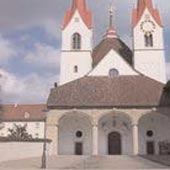 |
The foundation of the monastery dates back into the year 1027. Benedictine monks from the monastery of Einsiedeln settled Muri in 1032. During a period of 800 years, the monastery of Muri developed to its form and size today. The Roman crypt, the Gothic chancel and the Baroque center church, completed with an octagon in 1694, testify the church’s building long history. Since 1960, a small group of Benedictine monks have settled again here in Muri.
It is very likely that there was already a small swallows-nest organ at the North wall of the nave in the Roman basilica in the 12th century. Definite news about the presence of an organ are testified from the 16th century: Balthasar Mygel from Basel built an new organ on the west gallery in 1557, Peter Rietsch renovated that organ and transferred it to the screen around 1586. Thomas Schott completed the first bigger organ with 30 stops on the west gallery in 1630. The second organ on the screen gallery was replaced in 1660 by a new organ, built by one of the monks, P. Johann Schnyder.
| |
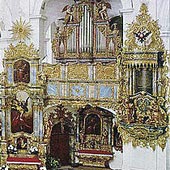 |
After the Baroque rebuilding of the abbey church to its present form in 1696, the screen underneath the octagon has been replaced by two side galleries, adjacent to the transept. The screen organ from 1660 was transferred to the Epistle side gallery, and Hans Melcher built another small organ on the Evangelist side gallery. Just before the interior was to be completely remodelled in Rococo style, abbot Gerold Haimb replaced the two screen organs by two completely new organs, built in 1743 by the famous organ builders Joseph and Victor Bossart.
Links and resources
Zurich (Saint Peter’s Church)
The oldest middle-age parish church of Zurich, Saint Peter, is located close to the Roman castle Lindenhof and dates back into the Roman time. Today’s church has had four predecessors: Pre-Roman around 800, Early Roman around 1000, Late Roman early 13th century (from this church, the tower and chancel is preserved), Late Gothic around 1450.
| |
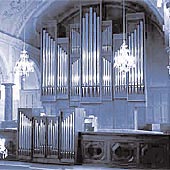 |
Today’s building has been built in 1705-06, it was the first reformed new church building in Zurich. In the interior baroque nave, fragments of frescoes from the 14th and 15th centuries are still preserved. The stuccos are created by Salomon Buerkli from Zurich and Franz Schmutzer from Wessobrunn (pillars). When the nave was restored in 1970-74, the facade paintings from 1706 have been restored, too. The baptism font with baroque stuccos is from 1598, the choir stalls from 15th century, the pulpit-screen from 1706. he tower has the largest clock face in Europe (diameter of 8,70 m), and housers five bells from 1880, the largest (A-flat) has a weight of 6,2 tons.
The present organ was built by the French firm Muehleisen Orgelbau from Strasbourg in 1974 and has been renovated in 1997 by Thomas Waelti from Guemlingen.
Links and resources
The day to day…

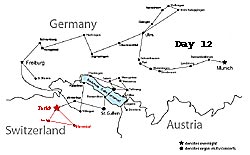
 Notes from the Road - travel log, day 12
Notes from the Road - travel log, day 12 Michael Barone’s pictures from the tour
Michael Barone’s pictures from the tour Images from the Kuhn Organ Shop
Images from the Kuhn Organ Shop Images from Muri Abbey
Images from Muri Abbey Images from Saint Peter’s, Zurich
Images from Saint Peter’s, Zurich Day 11 - Saint Gallen & Zurich
Day 11 - Saint Gallen & Zurich Main Tour Page
Main Tour Page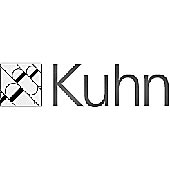
 Notes from the Road - travel log, day 12
Notes from the Road - travel log, day 12 Images from the Kuhn Organ Shop
Images from the Kuhn Organ Shop Kuhn Organ Builders
Kuhn Organ Builders Find detailed organ specifications in our Tour Book
Find detailed organ specifications in our Tour Book

 Notes from the Road - travel log, day 12
Notes from the Road - travel log, day 12 Images from Muri Abbey
Images from Muri Abbey Muri Abbey - Wikipedia
Muri Abbey - Wikipedia History of Muri Abbey
History of Muri Abbey Complete History of Muri Abbey
Complete History of Muri Abbey Find detailed organ specifications in our Tour Book
Find detailed organ specifications in our Tour Book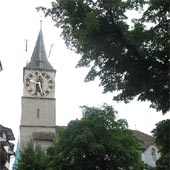

 Notes from the Road - travel log, day 12
Notes from the Road - travel log, day 12 Images from Saint Peter’s, Zurich
Images from Saint Peter’s, Zurich Saint Peter’s website
Saint Peter’s website Description Saint Peter’s
Description Saint Peter’s Find detailed organ specifications in our Tour Book
Find detailed organ specifications in our Tour Book

